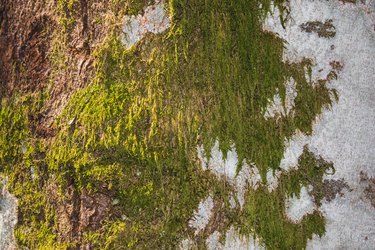
Moss adds a natural beauty to areas such as trees or stones outlining your patio, but in some cases, you might not want it in places like on your garden statues. Instead of using harsh toxins to get rid of the moss, use regular white vinegar instead. Vinegar has the power to eradicate moss, but it could also kill other plants or make the area inhospitable to new plant growth in the near future, so use it with caution. Here is how to kill moss with vinegar.
Vinegar Spray Solution
Video of the Day
One simple tactic for killing moss with vinegar is to mix equal parts water and white vinegar in a spray bottle and then liberally spray the problem areas with the solution. Choose a day when there's no rain in the forecast, as the rain might wash away the solution or further dilute the vinegar. Check the sprayed area in an hour or later in the day; the moss should look faded or yellowy and not as vibrant as before. If it still looks as healthy as ever, spray more of the solution on it or carefully apply full-strength vinegar to only the moss without letting it get on other plants.
Video of the Day
When the moss dies, it's fairly easy to lift or scrub off some surfaces depending on its location and the type of moss. Grab a bit and see if it comes up easily (since moss has shallow roots) or shove it off with a broom. If it's a stubborn, carpetlike layer growing on the patio or driveway, use a tool such as a hoe or a flat-blade shovel, working the blade between the moss and the hard surface and being careful not to scratch the hard material. With some pressure, the moss should come out in patches. If the moss is on a different type of surface, such as a statue or a wooden deck, use a nylon-bristle scrub brush to scrub it away.
Vinegar works particularly well on brick and porous surfaces. Since porous materials absorb moisture, they also absorb the vinegar solution, making the surface less hospitable for new moss growth. If you're using it in an area surrounded by other plants, do your best to block the spray from getting on anything else. Spray or even pour a few drops of the vinegar mixture directly on the moss, doing your best not to saturate the ground with it.
Preventing Future Moss Growth
Moss tends to grow in areas with lots of moisture or humidity and shade. For instance, if your lawn sprinkler wets one area of a patio that doesn't get much sunlight, that area is far more likely to develop moss than the sunny, dry portion of the same patio. While you can't change whether your house blocks the sunlight on part of your deck or patio, you can move furniture and plant pots around, effectively adding sunlight to the formerly shady areas. Repair anything that leaks into the mossy area, such as your home's gutters, or switch the method of watering nearby plants so the formerly mossy area doesn't get much moisture.
If you can't change the level of moisture or shade for the problem area and you also can't move the object upon which the moss grows, clean that surface regularly with either water and a scrub brush, soapy water and a scrub brush, or a spritz of the vinegar solution whenever you notice spots of green atop the item.